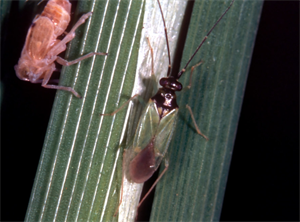Rice bug
Pacific Pests, Pathogens, Weeds & Pesticides - Online edition
Pacific Pests, Pathogens, Weeds & Pesticides
Rice bug (419)
Cyrtorhinus lividipennis
Asia, Africa (Mauritius), North America (Hawaii), Oceania. It is recorded from Australia, Fiji, Guam, Northern Mariana Islands, Papua New Guinea, Samoa, Solomon Islands, and Vanuatu.
Planthoppers and leafhoppers in rice fields and on wild grasses.
Cyrtorhinus lividipennis is a light green elongated mirid bug with green membranous wings and black spotted thorax (Photos 1&2). It feeds on plants of rice and grasses as well as the eggs of planthoppers and leafhoppers, and young nymphs. Eggs are laid inside plant stems, and each female produces up to 250 eggs, but this depends on its prey. Development from egg to adult takes 2 to 3 weeks. Each bug preys on up to 20 eggs daily and from 1 to 5 nymphs..
Spread occurs during early morning and evening flights, commonly over short distance up to 20 km. However, long-distance flights over hundreds of kms occur in India as the mirid follows one of its hosts, the white-backed planthopper, Sogatella furcifera.
According to CABI, "Cyrtorhinus lividipennis is one of the most abundant and effective predators of the eggs of leafhoppers and planthoppers in ricefields"1. It also occurs on grasses. Its greatest impact appears to be on populations of brown planthopper, Nilaparvata lugens (see Fact Sheet no. 64). But observations in Solomon Islands found that it was not always effective in preventing outbreaks of the brown planthopper. By contrast, Cyrtorhinus liividipennis has been reported to be effective against the whitebacked planthopper, Sogatella furcifera, in Malaysia.
Look for rapidly moving elongated insects with black head and thorax, and green wings. Look to see if they are feeding on the rice plants, probing for eggs of planthoppers and leafhoppers, or sucking nymphs.
DANGERS FROM USING PESTICIDES
The rice bug is susceptible to broad-spectrum insecticides. Keeping high numbers of rice bugs is important as they are the main predators of eggs and nymphs of planthoppers (Nilaparvata lugens and Sogatella furcifera). If rice bugs are destroyed by insecticides, this can lead to a rapid increase in the populations of planthoppers. If the number of nymphs rises to 400-500 per plant, there is a chance that browning and drying of the rice will occur, known as 'hopperburn'.
IMPORTANCE OF NATURAL ENEMIES
If natural enemies, rice bugs, spiders, and others, outnumber planthoppers, the recommendation from IRRI is not to treat the crop with an insecticide. The risk of hopperburn is low. This recommendation even applies to crops that have already suffered from hopperburn from brown planthopper.
IMPORTANCE OF VARIETIES
However, it is important to use a resistant variety to planthoppers, and to monitor insects in the rice crop weekly.
AUTHOR Grahame Jackson
Information (and Photos 1&2) from Plant Bug. In: Beneficials. Rice Knowledge Bank. IRRI. (http://www.knowledgebank.irri.org/images/docs/beneficial-organisms-that-attack-insect-pests.pdf); and Planthopper. Rice Knowledge Bank. (http://www.knowledgebank.irri.org/training/fact-sheets/pest-management/insects/item/planthopper); and from 1CABI (2018) Cyrtorhinus lividipennis. Crop Protection Compendium. (https://www.cabi.org/cpc/datasheet/17539).
Produced with support from the Australian Centre for International Agricultural Research under project HORT/2016/185: Responding to emerging pest and disease threats to horticulture in the Pacific islands, implemented by the University of Queensland and the Secretariat of the Pacific Community.





